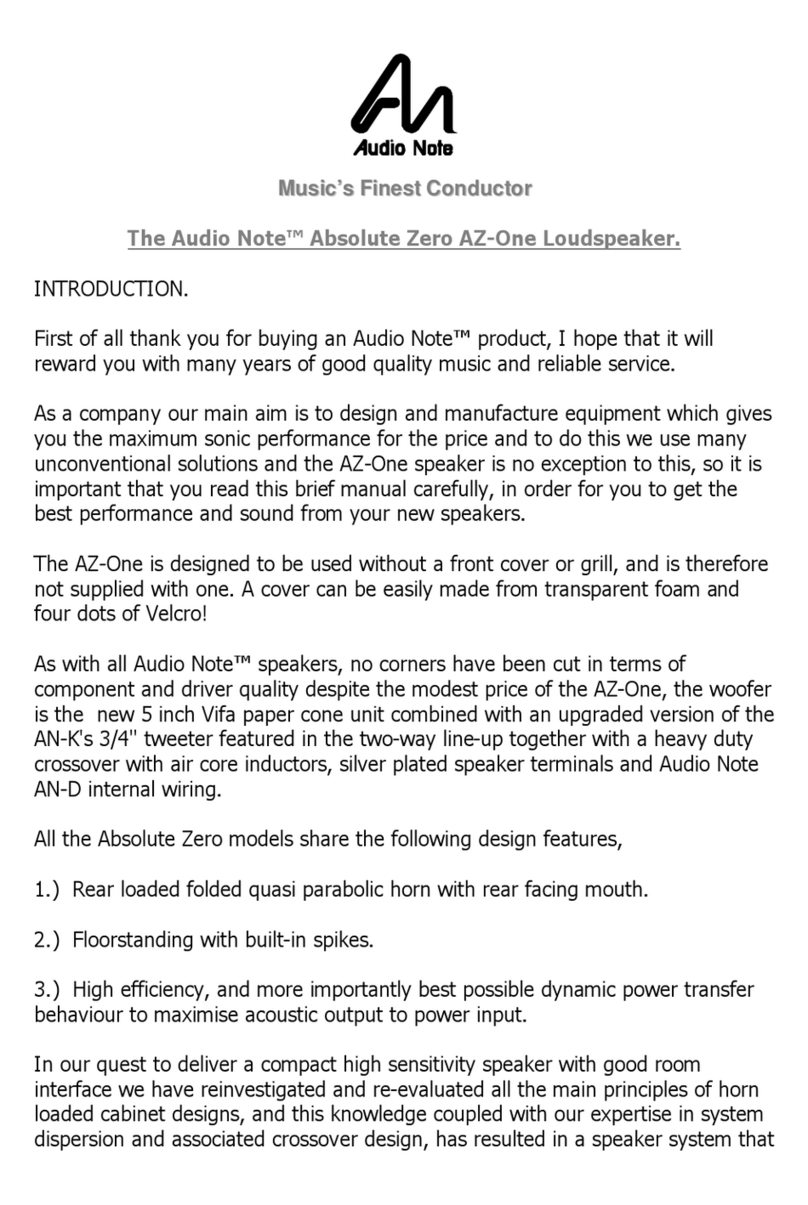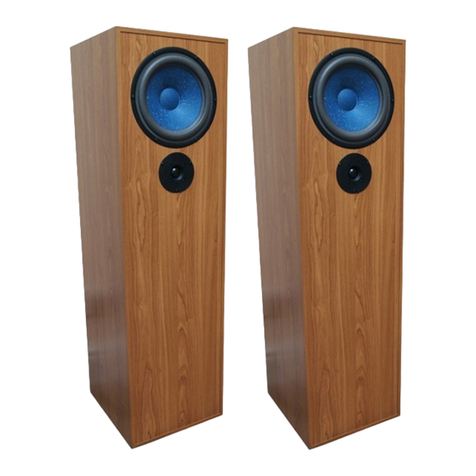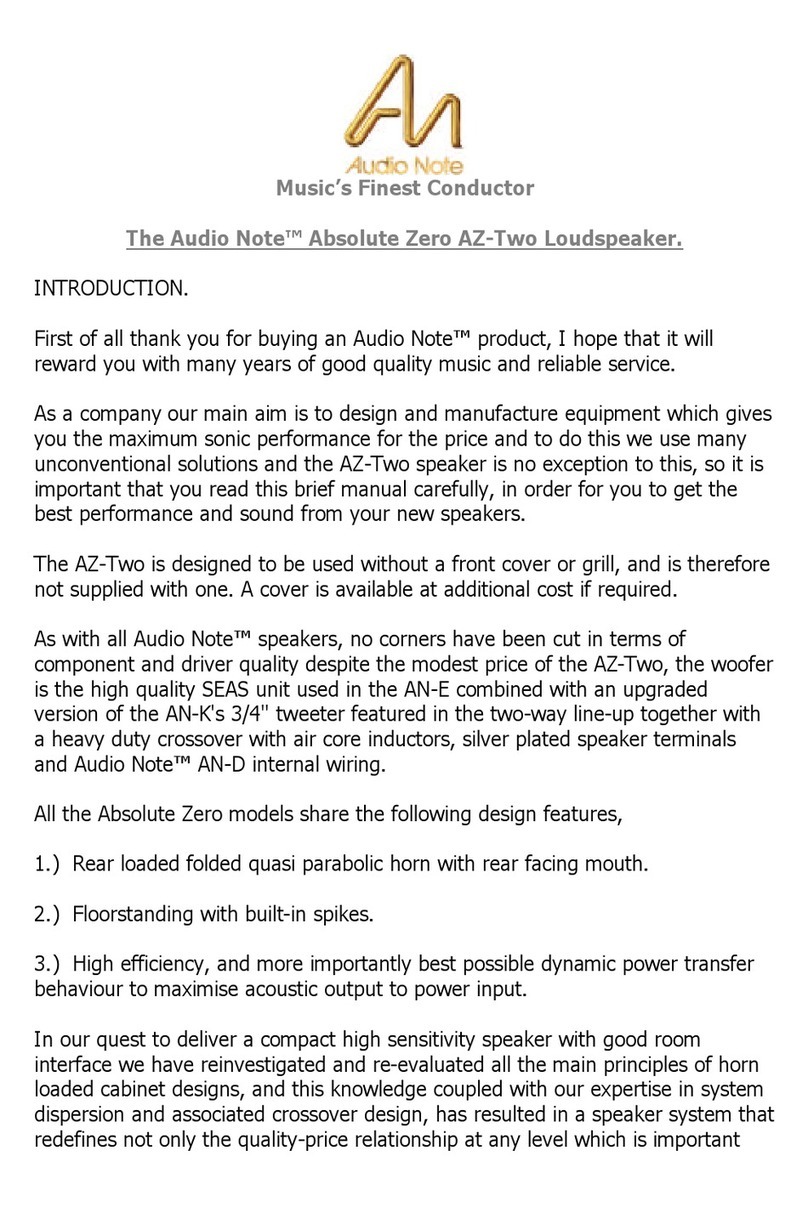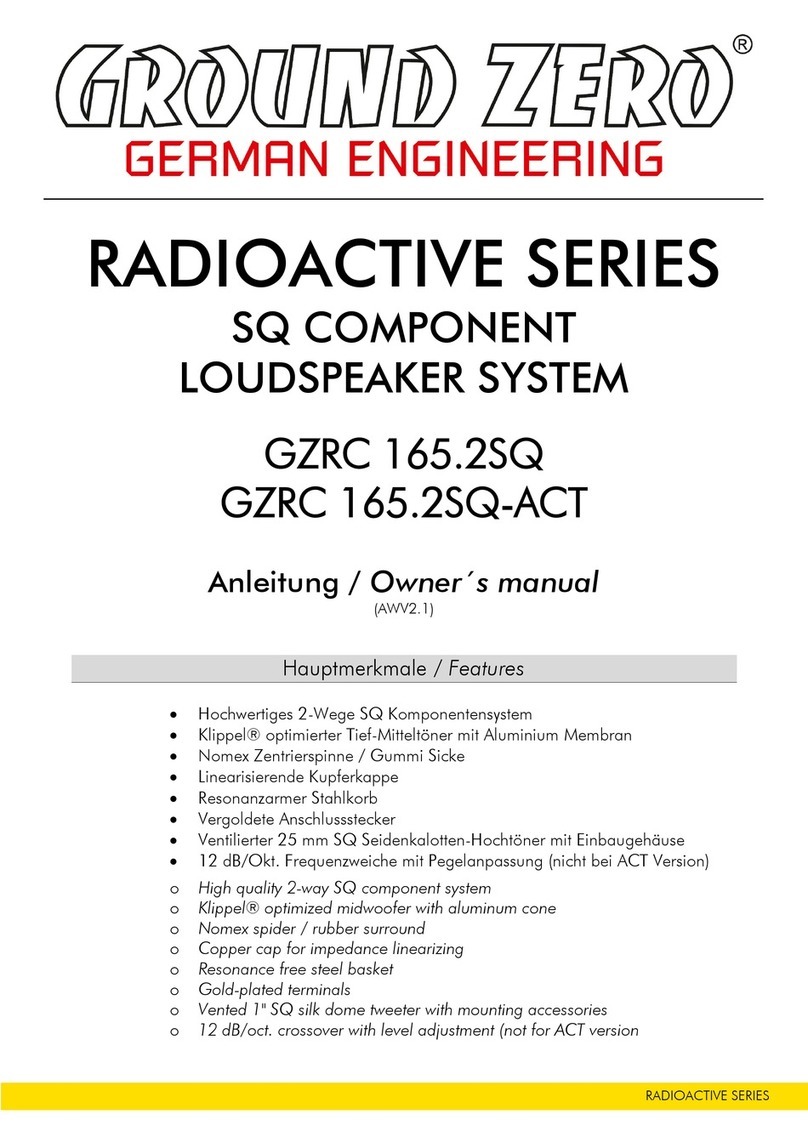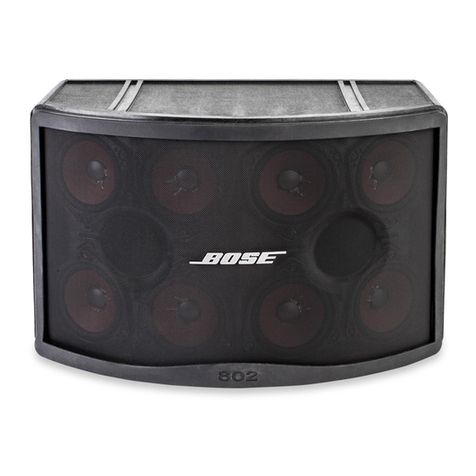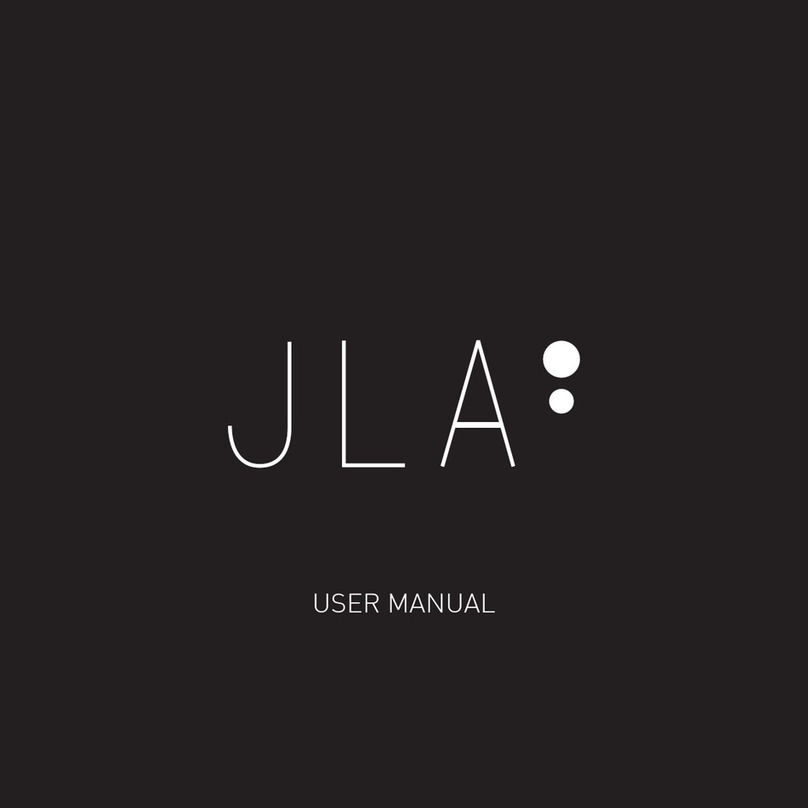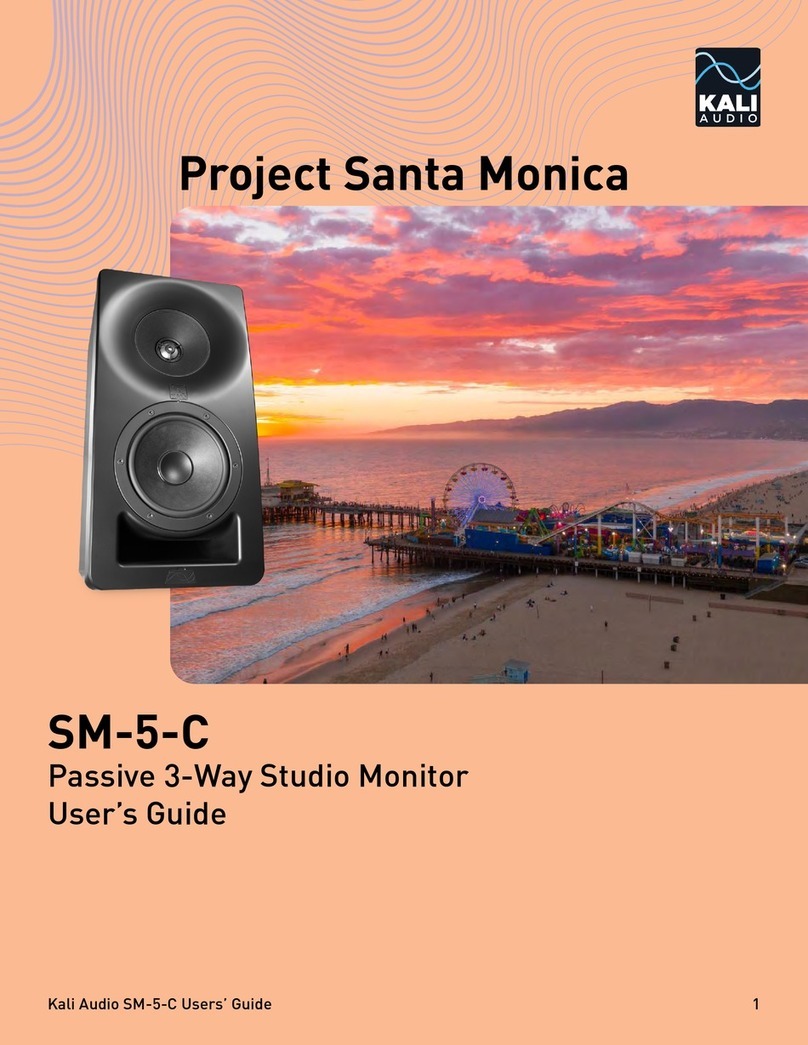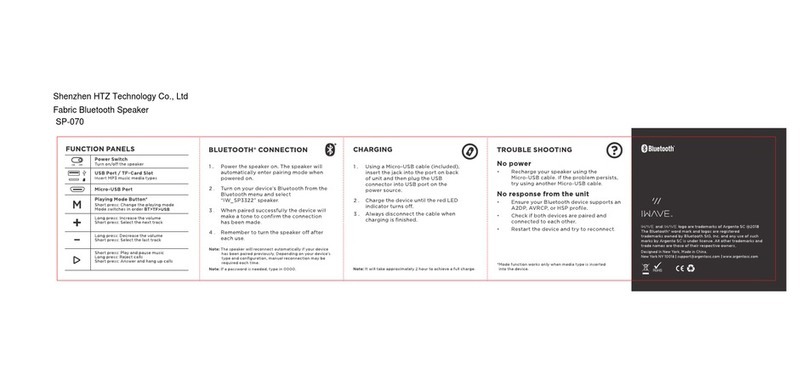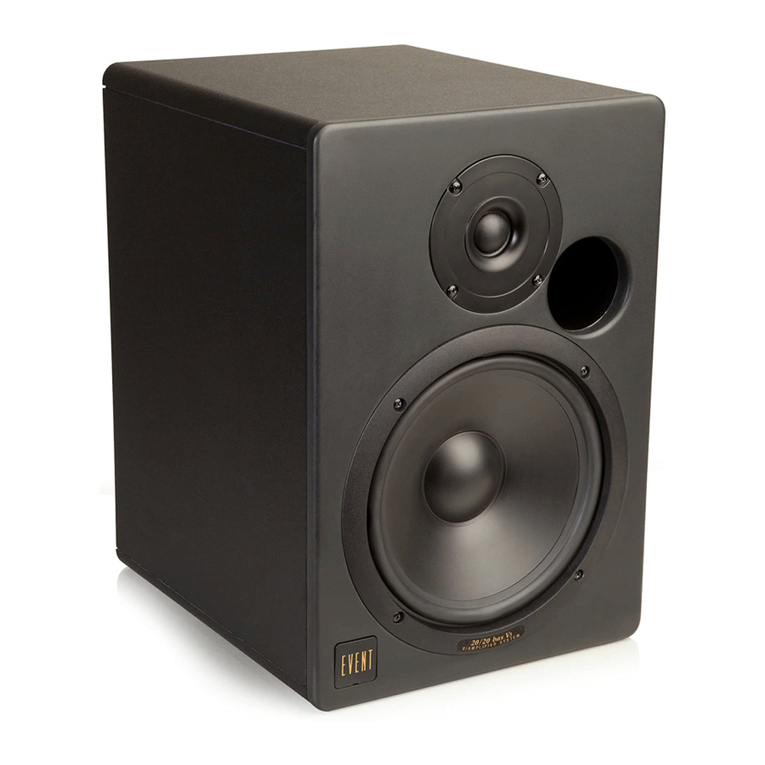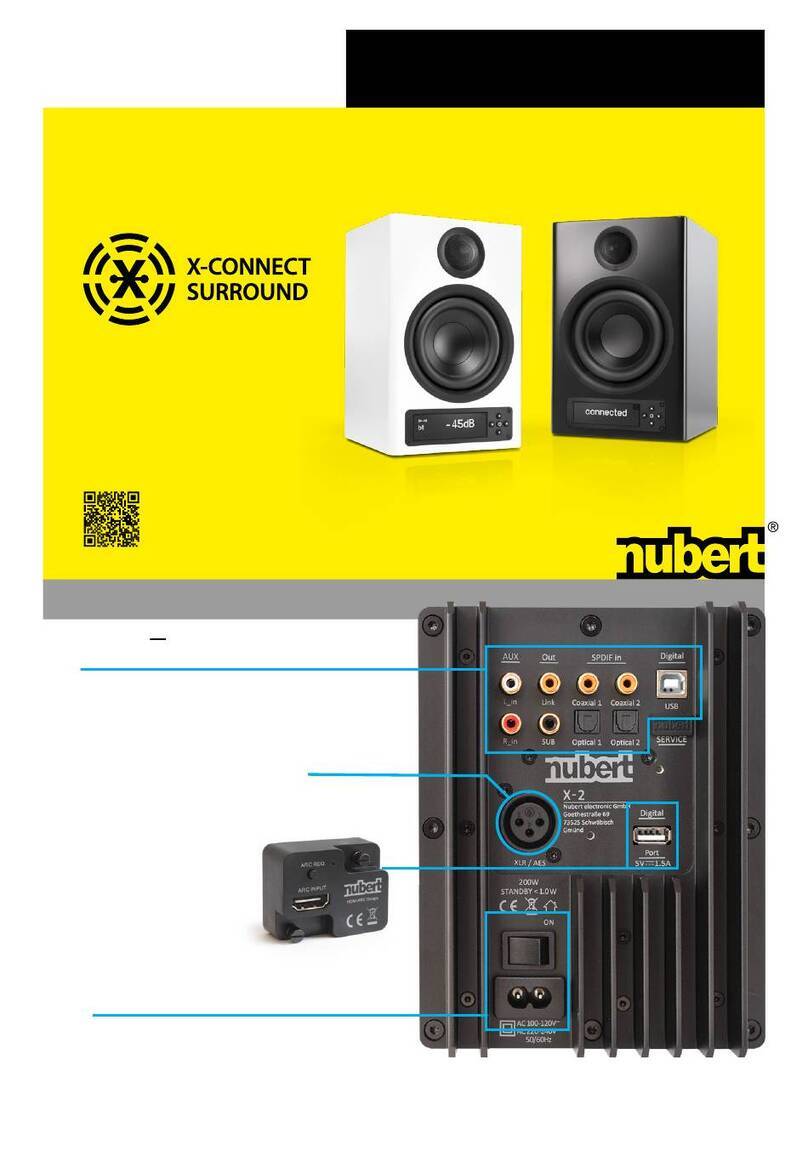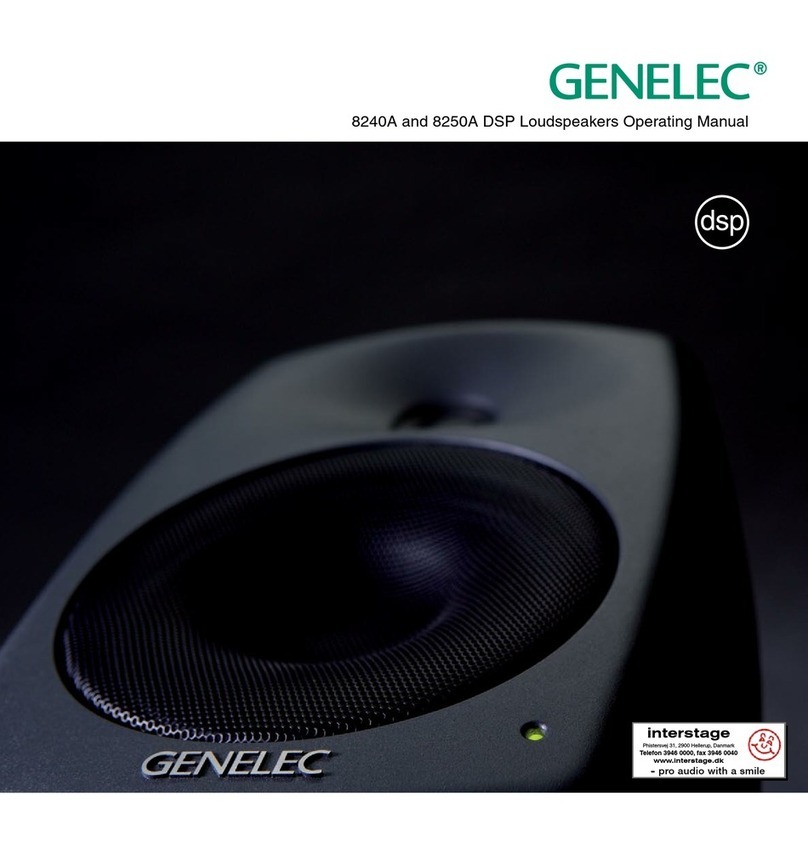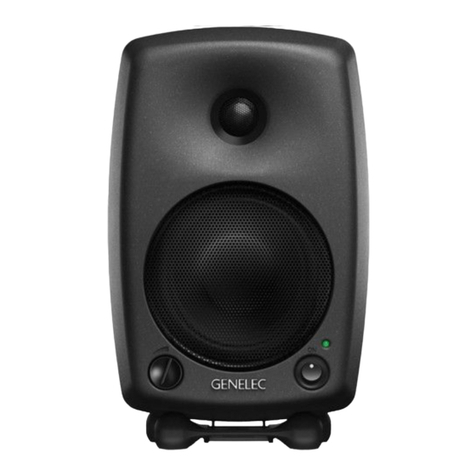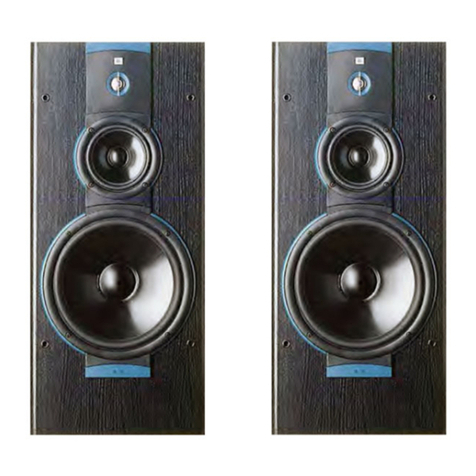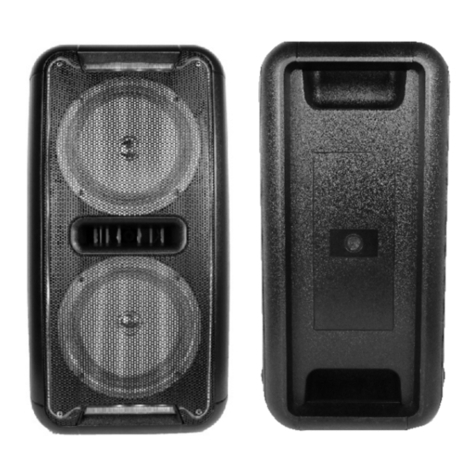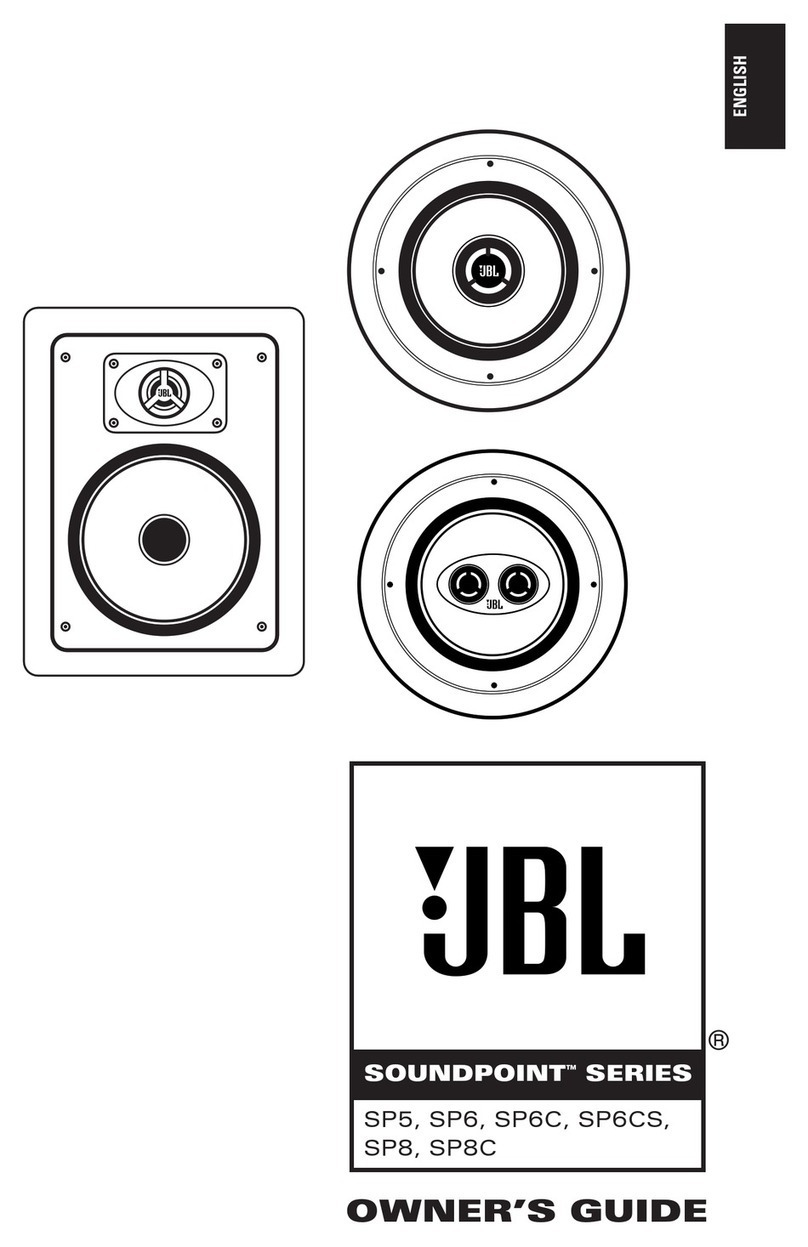Audio Note AN-E/D User manual

July 05 1
Audio Note AN-E/D Loudspeaker
Owner’s Manual
Contents
________________________________________________________
Unpacking Instructions
1
Introduction
2
Room Placement
3
Connection
4/5
Bedding In
6
Care and Maintenance
6
Schematic Diagram 7/8

July 05 2
UNPACKING INSTRUCTIONS
Firstly, inspect the outer carton for any signs of shipping damage. If you see or suspect that there is
damage, inform your dealer as soon as possible.
If the shipping carton looks intact, proceed as follows: Turn the box upside-down, and open the
bottom end of the shipping carton, folding the four bottom flaps outward. Now, holding the inner
packing material in place, tip the box over onto the open bottom end, and simply lift the carton
away.
Be sure to save the cartons and all packing materials.
At this time, please fill out the warranty card, putting both serial numbers and the date of purchase
on the card. The serial numbers are on the rear of the speakers below the input terminals and on
the outside of the packing cartons.
Save your purchase receipt. Your Audio Note AN-E/D loudspeakers are guaranteed against faulty
workmanship and material failure for 5 years from date of purchase. The warranty is fully
transferable, provided the original receipt for the purchase can be produced.

July 05 3
Introduction
Congratulations on your purchase of the Audio Note AN-E/D loudspeaker.
We hope they will give you many hours of musical satisfaction and trouble free listening.
The ideal loudspeaker would be 100% efficient. In other words it would convert all of the
electrical energy at its input into mechanical energy in the form of moving air (sound waves) at its
output.
Unfortunately, it is impossible to achieve perfection due to energy losses within the materials used,
but high efficiency remains a most desirable objective. There are NO benefits in making the job of
an amplifier more difficult than is absolutely necessary. The high powered complex amplifiers
required to drive inefficient loudspeakers are themselves poor energy converters and as such are
invariably inferior to more simple, lower powered designs.
The usual means of achieving maximum efficiency is by the use of horn loading. To achieve good
low frequency bandwidth, this usually requires large, intricate and expensive cabinets which, unless
extremely carefully designed and built, will impose distinctive characteristics of their own onto the
sound.
However, the Audio Note AN-E/D Loudspeaker is an infinite battle design, where the cabinet is
made from materials that compliment the workings of the chosen drive units, where instead of
trying to dampen the resonances in the cabinet, we place them in frequency bands where they aid
and enhance the operation of the drive units. This novel and difficult method helps ensure
maximum efficiency and dynamic behaviour.
The drive units employed in the AN-E/D are manufactured to our specification and coupled with
the crossover to give an extremely even load characteristic and a very flat power and frequency
response that remains within tightly controlled limits throughout the working bandwidth of the
design.
The individual adjustment of each crossover network to a known reference allows each pair of
loudspeakers to achieve an unparalleled degree of sample to sample consistency; not only within
pairs of loudspeakers, but also from one pair to another. This adjustment, carried out under
dynamic operating conditions compensates for the slight variations that always exist in drive units
and assures precise uniformity of sonic performance. Complete quality assurance can only be
achieved by such a system of 100% sample testing.
The crossover is hardwired and incorporates careful location of components, both in relation to
each other, but also in relation to the woofers magnets, which influences the behaviour of the
crossover a great deal.
The crossover uses precisely matched air cored chokes and selected bipolar and polypropylene
capacitors. For internal wiring, Audio Note’s AN-D99.99% pure copper cable is used.

July 05 4
ROOM PLACEMENT
The Audio Note AN-E/D is a highly versatile loudspeaker, which will provide satisfying
performance in most listening environments. For optimal tonal balance, the AN-E/D should be
used on a stand of 10 inches (24-27cm) in height. A light open-frame stand will give good results
provided it has spikes rigidly coupling it through the carpet to the floor.
The best results, however, will be obtained using a spiked high-mass stand which, if correctly
placed, can hold the speaker so well that even if the top of the speaker is pushed, it will not move at
all!
The speaker should be coupled to the stand by placing 4 pea-sized balls of “blue tack” (it is actually
white) on the stand’s top and pushing the speaker down onto these so that they are flattened. We
have included some of this “blue-tack” with the instructions and warranty card.
The distance between the speakers and the rear wall should ideally be about 30 cm to 1 metre. As
all listening rooms are different, the Audio Note AN-E/D’s considerable flexibility in positioning is
very useful, as it makes it possible to adjust the overall balance of the system.
The distance between the speakers should be slightly less than the distance from the speakers to the
listening area. For best stereo imaging and sound staging the listener should be equidistant from
the 2 speakers.
The AN-E/D is designed to have a very wide listening window, so they will allow considerable
angling to reduce early sidewall reflections interfering with the direct sound from the speakers.
These reflections will greatly affect tonal and stereo balance.
The angle at which the speakers are aimed at the listener will vary from room to room.
Three alternatives are to:
1) Position the speakers parallel to the rear wall.
2) To toe the speakers in to aim at the listening area.
3) To toe the speakers even more to aim 1-2 metres in front of the listening area.
Experimentation is vitally important to achieve optimum results in any given environment.

July 05 5
CONNECTING THE AN-E/D
Before making any connections always turn off your amplifier.
The length and type of speaker cable used in your system will have an audible effect. The AN-E/D
is wired internally with a high quality Audio Note cable, type AN-D. It is recommended that you
use a similar type of speaker cable in order to maintain the tonal balance and dynamic
characteristics that we designed the AN-E/D for.
Although the binding posts on the back of the speakers accept bare wire, it is recommended that
the cable is terminated with soldered 4mm banana plugs. Even if it seems unnecessary, it is
advisable to use equal lengths of speaker cable to each speaker.
Most speaker cable is marked so that it is possible to distinguish between conductors by the colour
of the insulation or by a white stripe or small raised edge along one conductor. Correct phasing of
the speakers is vital for sound quality.
Very tight and positive connections are necessary. Care should be taken to ensure that the
connections are neat and that no strands from the two conductors are allowed to touch.
At the rear of each speaker there are two pairs of red and black terminals marked LF and HF.
Under normal operating conditions these pairs are linked across by connecting links (this is how
they arrive to you from the factory), so that the input to one pair of terminals will be fed to both.
Your speakers should be wired in phase with each other. Proper phasing will be assured if the
speaker cables connect the red speaker input to the plus (+) or “hot” amplifier output terminals, and
the black speaker input terminals to the negative (-) or “ground” amplifier output terminals (see
figure 1).
Should you be interested in absolute phase of your system, a positive voltage at the red terminal of
the speaker will cause all drivers to move outward, provided the links are in place.
The facility to split the crossover on the AN-E/D allows the speakers to be operated in a bi-wired
or bi-amplifier mode. The crossovers are split by removing the connecting links between the HF
and LF terminals on the rear of the speaker. Bi-wiring (see figure 2) involves running two sets of
cables to the rear of each speaker so that the LF section of the crossover is fed by one set and the
HF section by the other. Both sets of cable are connected together to the corresponding pair of
terminals on the back of the amplifier. Two preamplifier outputs per channel are required for any
of the following bi-amping set-ups.
It is strongly recommended that the same type of speaker cable is used throughout.

July 05 6
FIGURE 1 –CONNECTION WITH
SINGLE STEREO AMPLIFIER
FIGURE 2 –BI-WIRE CONNECTION WITH
SINGLE STEREO AMPLIFIER

July 05 7
Bi-amplifying involves using 2 stereo or 4 mono power amplifiers to drive the loudspeakers. When
using two stereo power amplifiers, it is possible to bi-amplify in two ways (see figures 3 and 4).
Figure 3 shows each stereo amplifier driving one loudspeaker channel. One channel of each
amplifier is driving the LF unit and the other is driving the HF unit of each speaker.
Figure 4 shows one stereo amplifier driving the LF units of both loudspeaker channels and the other
amplifier driving the HF units of both loudspeaker channels.
FIGURE 3 –BI-AMPING WITH ONE STEREO
AMPLIFIER PER CHANNEL
FIGURE 4 –BI-AMPING WITH ONE STEREO AMPLIFIER
PER DRIVE UNIT FOR BOTH CHANNELS

July 05 8
Figure 5 shows a separate mono power amplifier driving each unit in the System. It is advisable to
use amplifiers of a similar quality and input sensitivity when bi-amping Audio Note speakers.
With very few exceptions, dynamic loudspeakers have a running in period, where the drive units
“loosen up”, during this time the bass unit will not display its full lower bandwidth and the tweeter
will sound slightly brighter than when run in. As the suspension of both drivers “softens up”, the
fullness of the bass and the smoothness of the treble will start to emerge.
We expect the AN-E/D to have a running in period of about a month, based on an expected use of
3 hours per day. This period can however vary considerably due to factors such as, music types,
listening volume and type of amplification used.
CARE & MAINTENANCE OF YOUR AUDIO NOTE AN-E/D
LOUDSPEAKERS
Care should be taken when using the loudspeakers with very high powered amplifiers. Although
the AN-E/D is reasonably tolerant and has high power handling, it is also very efficient and
therefore requires considerably less power than other similarly priced loudspeakers. If audible
distortion occurs the amplifier or the loudspeaker is being overloaded and damage is likely to
result.
Should you be unfortunate enough to damage a drive unit either by accident or misuse, please
ensure that it is replaced with an original Audio Note drive unit replacement kit and that the
relevant parts of the crossover are also replaced. This will maintain the speakers’ performance.
The durable finish of your speakers will maintain their appearance for many years to come with
minimal attention, and wiping over your cabinet with damp lint free cloth is all the general cleaning
FIGURE 5 –BI-AMPING WITH FOUR MONO
AMPLIFIERS

July 05 9
that is required. We recommend that you occasionally (perhaps once a year) wax the veneered
surface of your speakers.
Keep the speakers away from radiators or other heat sources and avoid prolonged exposure to
direct sunlight.
WARRANTY & SERVICING
Please take the time to fill out your warranty/registration card and mail it to us. This will ensure
that if service is ever needed, it will expedite your units’ return.
Audio Note warrants this product free from defects in materials and workmanship for 5 years from
original date of purchase from an appointed Audio Note dealer. In the event that your Audio
Note™ product requires servicing, please contact your Audio Note™ dealer. If the equipment
needs to be shipped, please use the original packaging and include a copy of the sales purchase
receipt, with a note explaining in as much detail as possible, the problems that you are experiencing
with the product.
Any modification not authorized by Audio Note will invalidate this warranty.
If you require technical support or have any questions, please direct them to your Audio Note™
dealer first or contact us directly.
Audio Note (UK) Limited,
25 Montefiore Road
Hove, East Sussex,
BN3 1RD,
United Kingdom
Tel: +44 (0)1273 220511
Fax: +44 (0)1273 731498
Email: [email protected]

July 05 10
TWEETERX-OVER
R1-5R0/20WADJUSTABLEWIREWOUND
R2,R3-1R0/10WWIREWOUND
C1-1.5uFBIPOLARELECTROLYTIC
C2-4uFBIPOLARELECTROLYTIC
L1 -0.68mHAIRCORE
R1
C1
C2
L1
C3
R2R3
+
-
-
+
C3C4
L2
+
-
WOOFERX-OVER
C3-4.2uFBIPOLARELECTROLYTIC
C4-10uFBIPOLARELECTROLYTIC
L2 -1.7mHAIRCORE
SCHEMATICDIAGRAMOF
AUDIONOTETYPE AN-E
Table of contents
Other Audio Note Speakers manuals
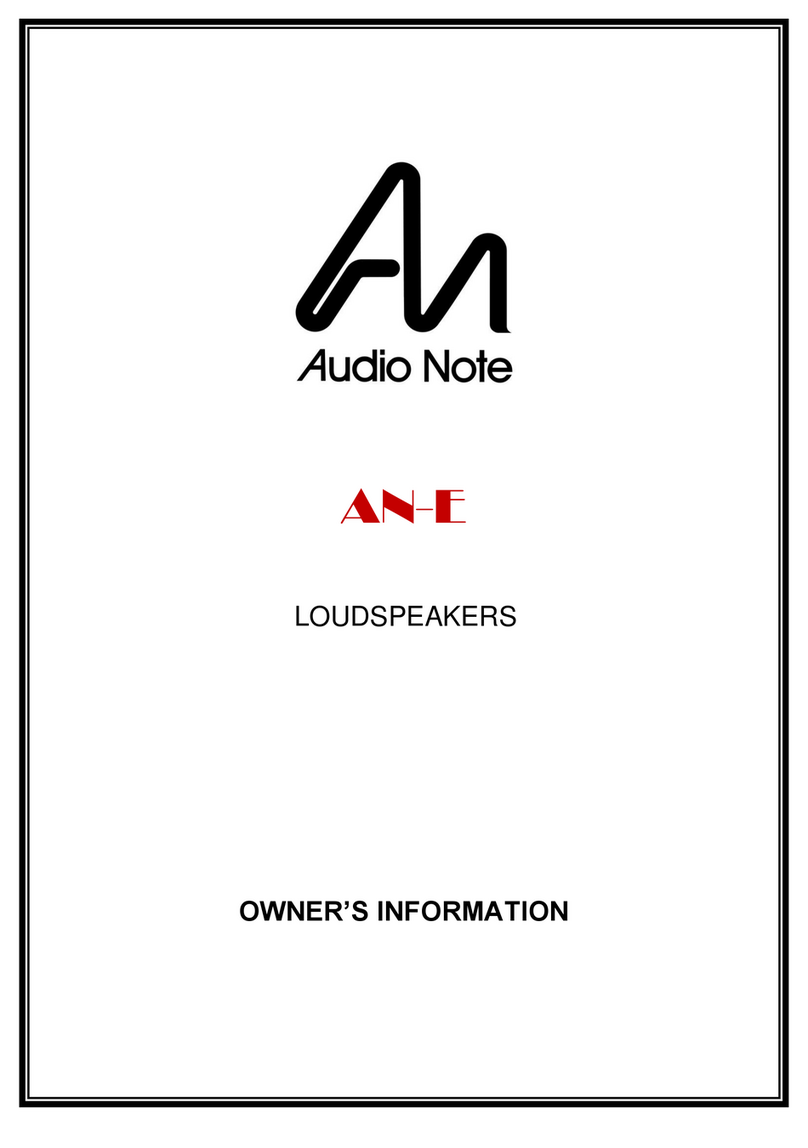
Audio Note
Audio Note AN/E Series Technical manual
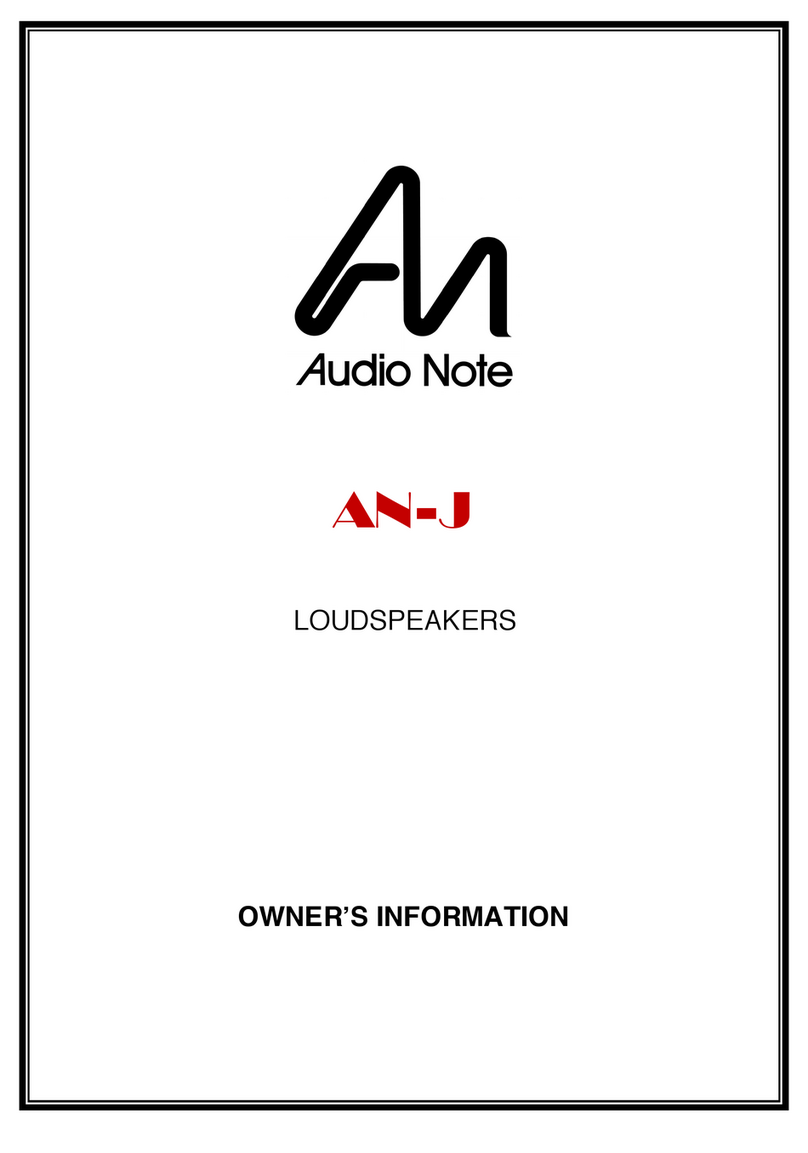
Audio Note
Audio Note AN-J Technical manual
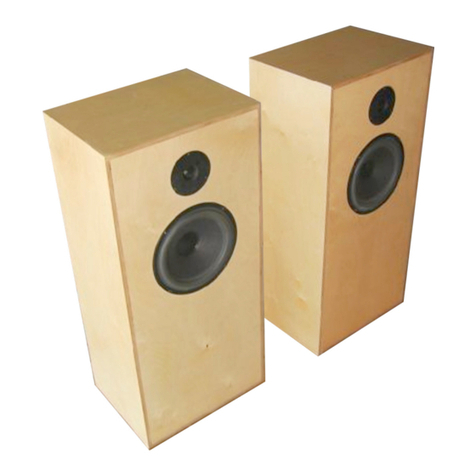
Audio Note
Audio Note Speaker Kit User manual
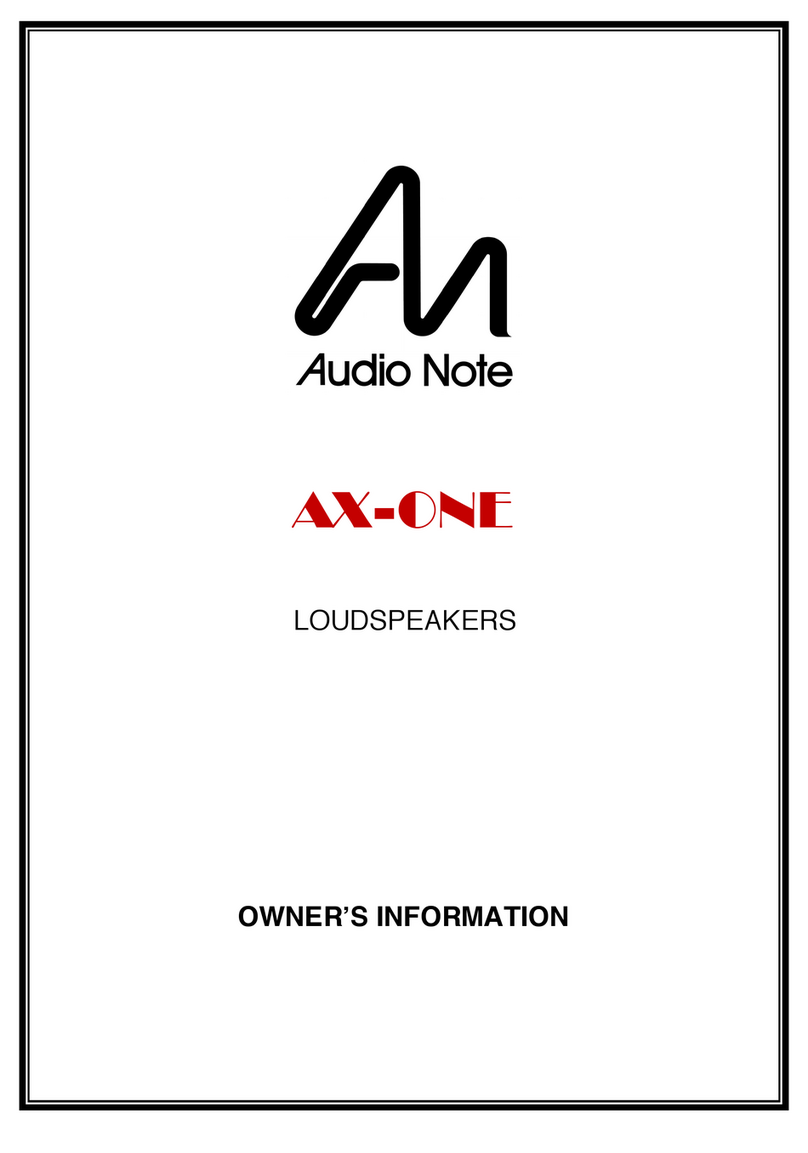
Audio Note
Audio Note AX-ONE Technical manual

Audio Note
Audio Note AN/E Series User manual

Audio Note
Audio Note AN-K Technical manual
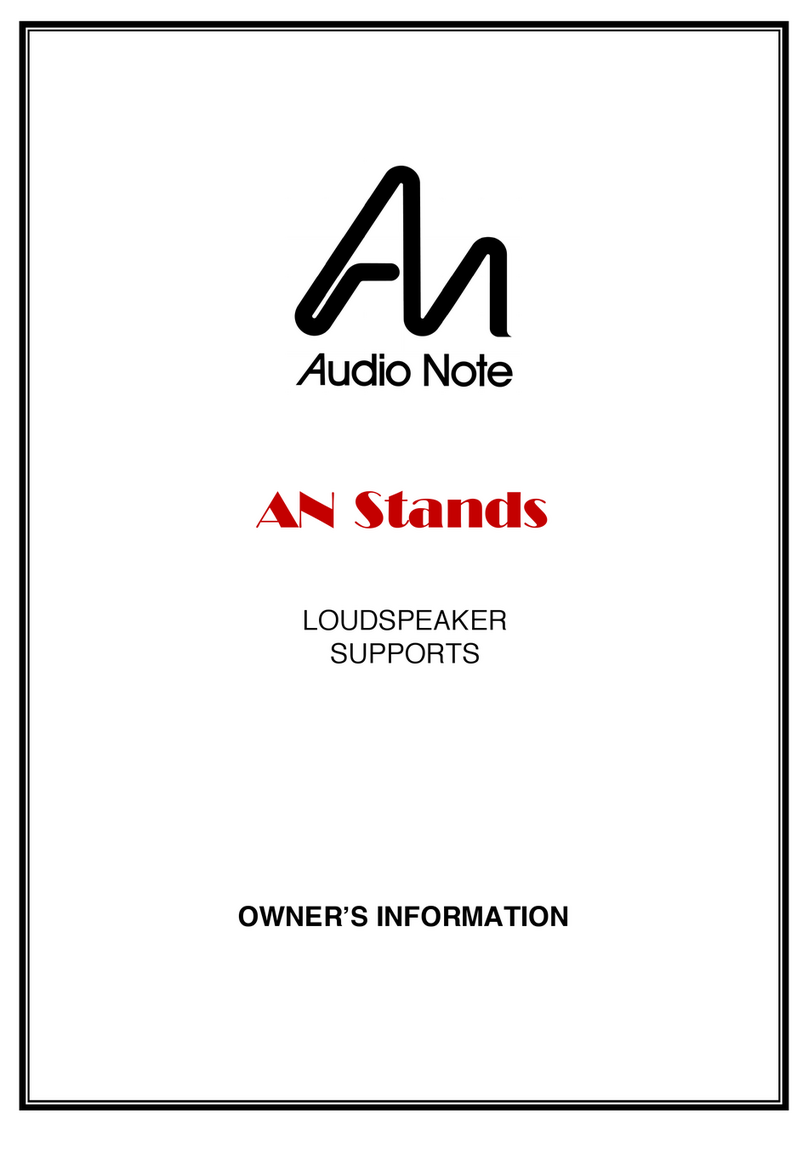
Audio Note
Audio Note AN Stands Technical manual

Audio Note
Audio Note AZ-TWO Technical manual
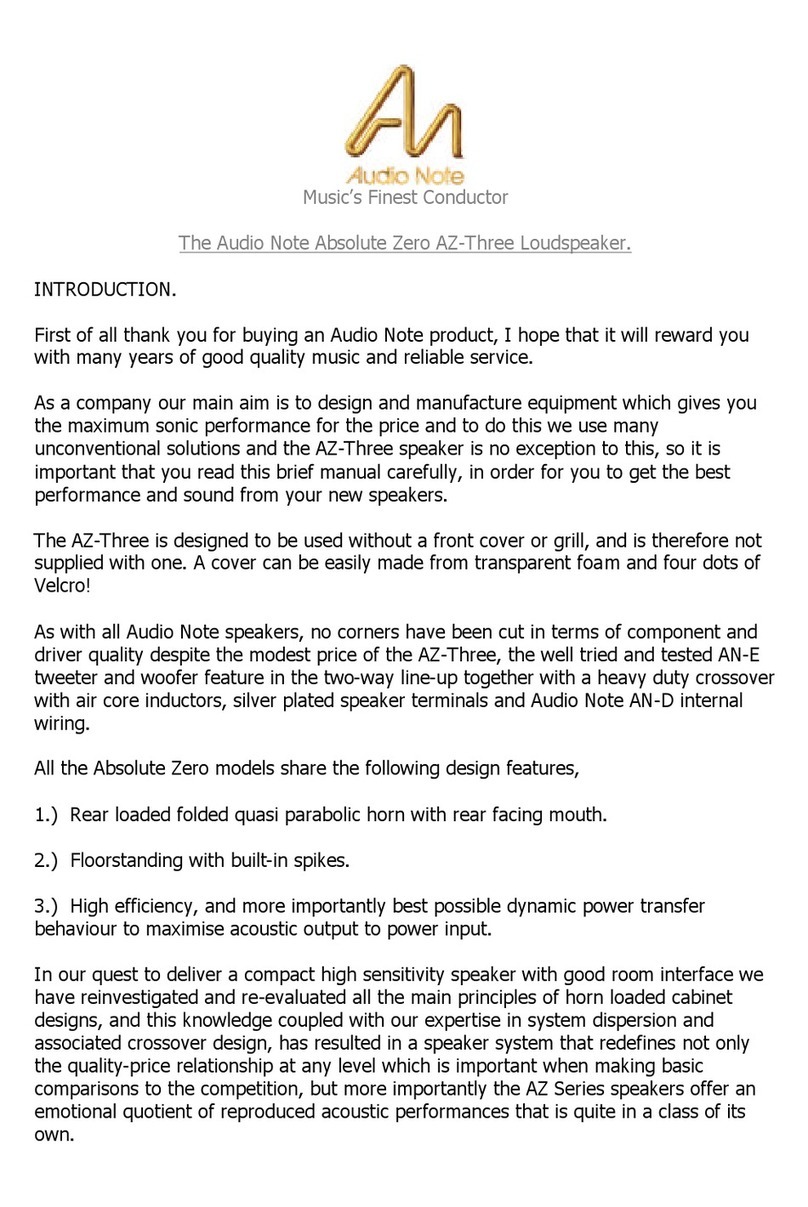
Audio Note
Audio Note Absolute Zero AZ-Three Loudspeaker User manual
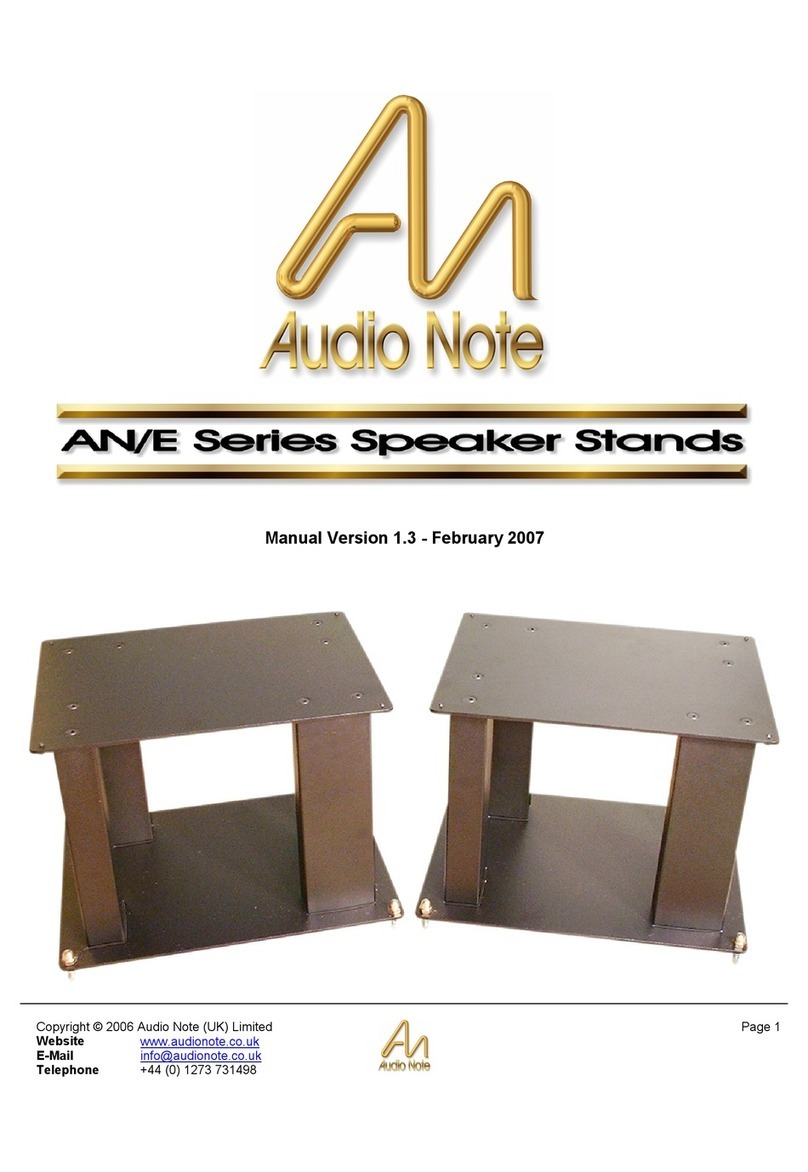
Audio Note
Audio Note AN/E Series Technical manual

